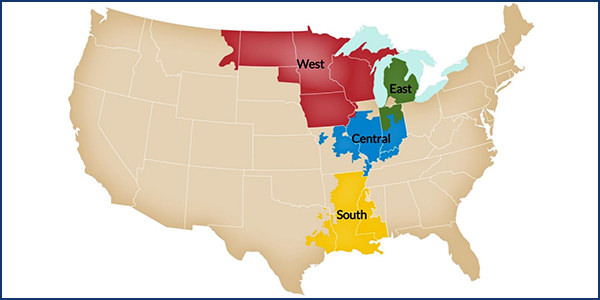MISO stakeholders sounded alarm bells this week, saying another round of prohibitively expensive system upgrades would render the RTO’s West planning region a “dead zone” for new generation.
MISO West — which includes Minnesota, Iowa, parts of the Dakotas and western Wisconsin — is again facing high system upgrade costs for interconnection hopefuls, this time from SPP studies of generator interconnections, or affected-system studies, along the seams.
SPP’s draft studies of a 2017 cycle of generation projects in MISO West recommend about $500 million of upgrades for 250 MW of projects.
“There are still a lot of coordination issues remaining with SPP,” EDF Renewables’ Anton Ptak said in raising the issue during the Interconnection Process Working Group’s (IPWG) teleconference Tuesday.
Several stakeholders agreed, saying that few projects will proceed in the west at this rate and characterizing the issue as a process failure. They said part of the problem lies in SPP using the stricter network resource interconnection service (NRIS) standard to model all service requests, making upgrades costlier and unnecessary in some cases. MISO uses the more relaxed energy resource interconnection service (ERIS) standard in its affected-system modeling.
“It is a bigger issue. Everyone should be concerned about this,” Savion’s Chad Craven said. “It’s basically going to roadblock everything in the west.”
Craven said the problem should alarm all stakeholders, not just interconnection customers and transmission owners. “The west is essentially going to be a dead zone,” he warned.
“We’re aware of the report and the costs that came from that report. … We understand the difficulties,” said Ryan Westphal, MISO’s manager of resource utilization. Staff said that if stakeholders have an issue with SPP criteria, they should follow the issue in that RTO’s interconnection stakeholder groups.
“MISO should significantly care about this. Without MISO trying to do something about it, it’s going to become a big problem and stalemate things in the west and then in the south,” Craven said. “If nothing else, MISO should be educating stakeholders on why this is happening.”
MISO Senior Corporate Counsel Christopher Supino said there are limits to what the RTO can do about SPP’s study process. He said FERC recently decreed that RTOs are free to choose between NRIS or ERIS modeling standards.
Stakeholders said MISO should make the effort to have meaningful conversations about the problem with them.
“It is extremely concerning. This is going to kill MISO West generation projects,” IPWG Vice Chair Angela Maiko said, adding that the August 2017 batch of projects will probably also be imperiled by high upgrade costs. She said the region runs the risk of never welcoming new generation unless it’s for replacement or surplus interconnection service.
Maiko said MISO may want to consider waiving its project withdrawal fees if SPP’s affected-system studies continue revealing high upgrade costs.
“In my opinion, this is a MISO issue. Even if SPP doesn’t return huge costs for [the] August 2017 [cycle], upgrades are going to cascade. You can see where the problem is going to persist. It’s a fundamentally huge issue,” Craven said, calling the situation “toxic.”
The RTO’s West region has been routinely flagged by stakeholders as a problem area for interconnecting generation. (See MISO West Planning Belies Upgrade Needs, Critics say.)
The Clean Grid Alliance, Solar Energy Industries Association and the American Wind Energy Association said recent upgrade costs have been raising renewable projects’ costs by more than 60% on average in MISO West.
A Siemens system impact study prepared for MISO in March showed that a cluster of 60 western wind generation projects dating back to 2018 and totaling 9 GW would collectively require more than $1 billion in transmission upgrades before they could interconnect.
The estimate prompted MISO to examine ways it could coordinate its interconnection upgrade studies and planning studies under its annual Transmission Expansion Plan. Its hope is to approve more multifunctional transmission projects. (See MISO Processing Heftiest Interconnection Queue Ever.)




